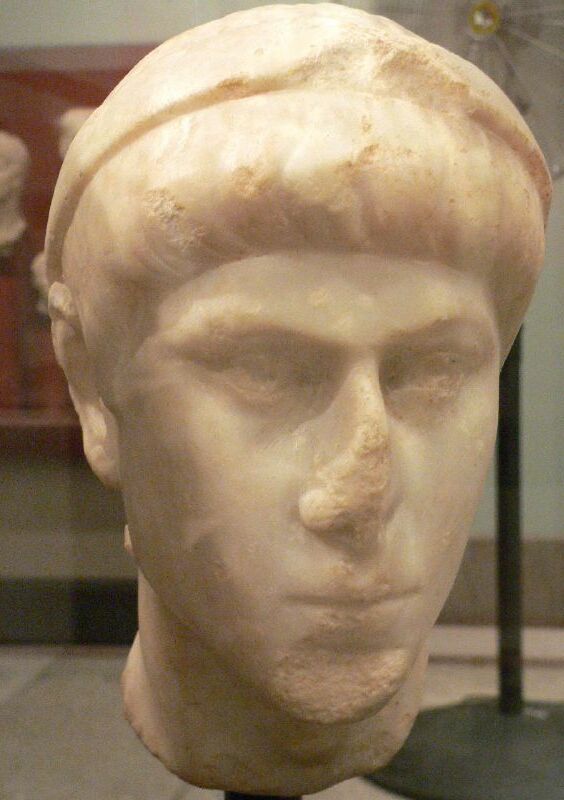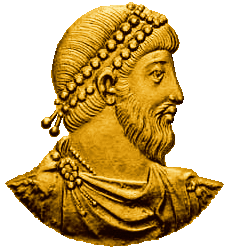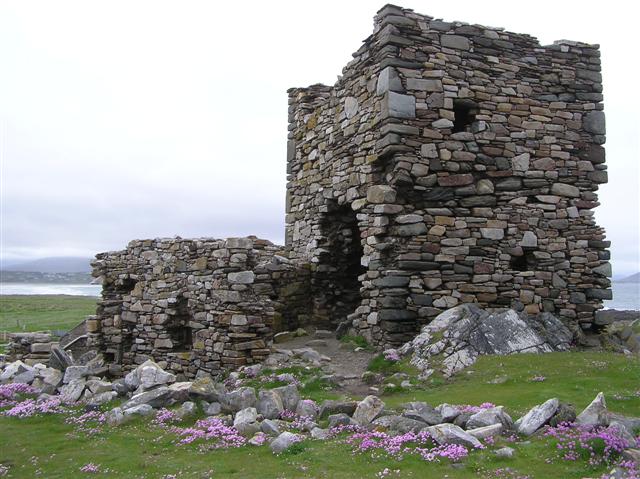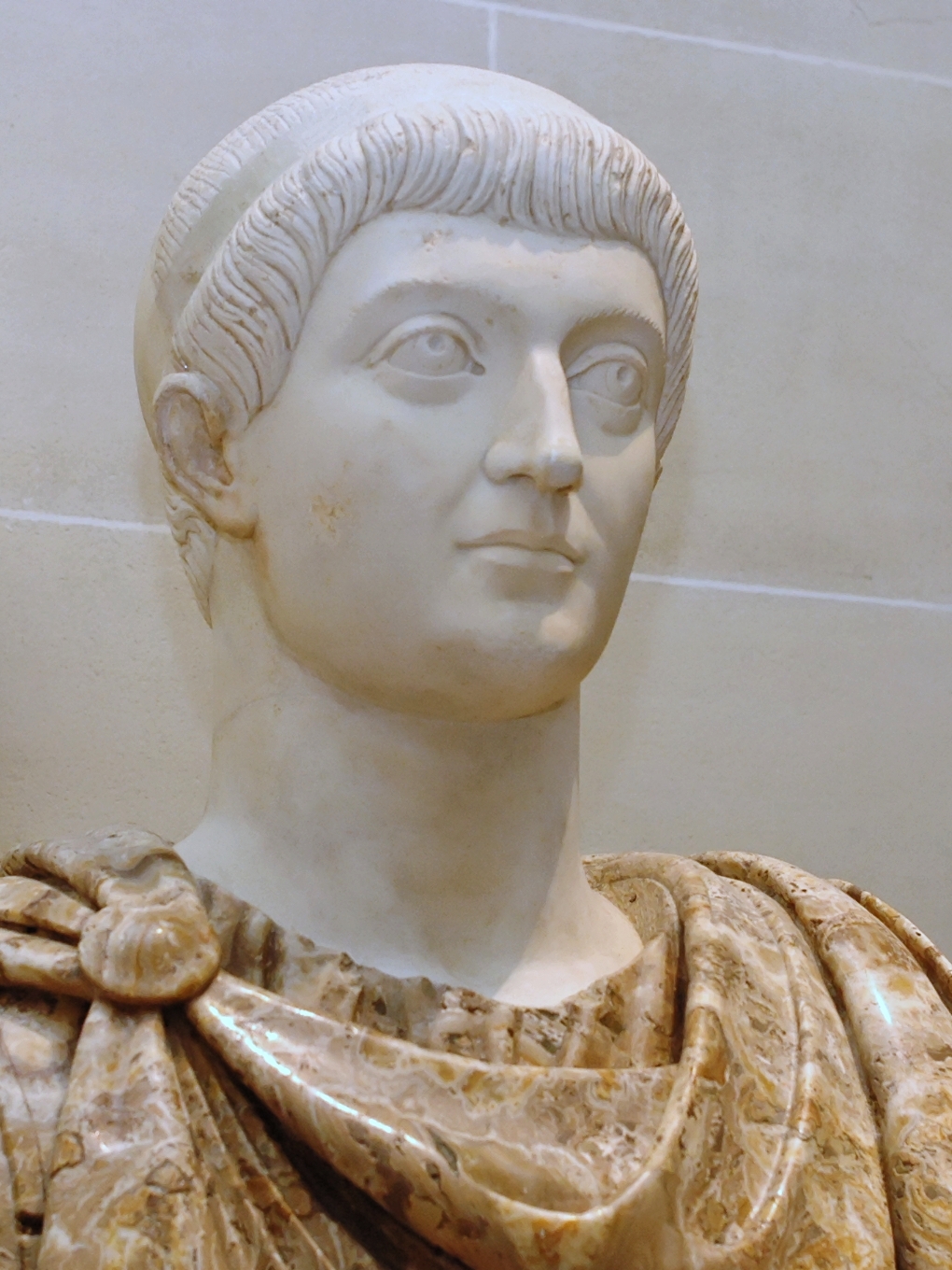 |
| Constantius II |
|
By 350 the emperor Constans was dead and a usurper, the half Briton, half Frankish
Magnentius was in power in the Western Provinces.
Constantius II was in power in the East. In Britain Flavious Martinus was the Vicarius; a governor in charge of the civil structure of the provinces. He was well respected by Britain’s nobility and was deemed to be fair and honest in his dealing with them.
Ammianus[1] a Roman historian of the time tells us of Martinus that he was:
“..a most just ruler, who had dared to lighten the unhappy lot of many…Martinus, who was governing those provinces as a substitute for the prefects, deeply deplored the woes suffered by innocent men..”
This shows that Martinus, although a nice guy had no real power. He was only a substitute for the role of Praetorian Prefect and this had profound affects for his authority after the revolt of Magnentius was put down.
Magnentius[2], called a barbarian by writers of the time[a], was born in Samarobriva (Amiens, north eastern France) of a British father and a Frankish mother. He was said to have been tolerant of both paganism and Christianity. He worked his way up the Roman ranks until he commanded the palatine legions - the Loviani and Herculiani seniores, personal legions of the Emperor Constans himself. He was raised to power in Autun when the Roman army became disgruntled with the behaviour of Constans and had him executed, after he had fled, near the pyrenees by one Gaiso (Consul in 351).
Magnentius must have visited Britain sometime in February 350AD, probably to raise taxes for his forthcoming war and to strip the country of some of its legions. He stripped Britain of all movable troops and emptied the frontier garrisons of Gaul to swell his ranks. For Magnentius, this was just the beginning of his claim for total power of the Roman world. He collected the armies of Britain and Gaul and called on his fellow Germanic Franks and Saxons plus Spaniards in support and started on his march first towards Trier then to Rome which capitulated in his favour. Magnentius tried to get recognition from Constantius as the rightful Emperor of the Western Empire but this was refused by Constantius, understandable, as the Flavian dynasty had held sway for 50 years since Contantine I.
 |
Magnentius,
the first Romano Briton to usurp power. |
In response to all this Constantius II invited Germanic tribes to cross the Rhine and enter Gaul. This was a spoiling tactic to hold up Magnentius and was to have far reaching effects. Magnentius though, due to his Frankish allies was able to bring some control to the Barbarians invited in by Constantius. Constantius however employed many more Germanic barbarians to swell his ranks. Magnentius for his part recruited Keltoi and Galatai. But his most enthusiastic followers, according to the emperor Julian himself:
"..were by virtue of their ties of kinship, Franks or Saxons, the most warlike of whom live beyond the Rhine and along the shore of the Western Sea." (Or. 1. 34c-d).
In 351AD these two massive armies met at the
Battle of Mursa Major in present day Croatia and in the ensuing battle and stalemate 52,000 men lost their lives. With such huge losses the Roman armies were seriously depleted and it would take a couple of years before Constantine could try again. But by 353 he had successfully beaten Magnentius at
Mons Seleucus in southern France.
One Gerontius (Keraint, Gereint) was Magnentius’ Comes Britanarium, commander of the armies. Gerontius was a Briton and shows the ties Magnentius had with the provinces and armies of Britain who had probably helped him to power in 350. Could this Gerontius be the Keraint ap Genedos of the Welsh genealogies? Is Genedos just a corrupted late Welsh form of Magnentius? Anyway, according to Welsh myth, Gerontius set his relatives up in positions of power in Britain. To Tegid (Tacitus) was given the far north, his descendent was Cunedda. To his other brother Eudaff he gives Wales. Keraints daughter Faustus marries Magnentius. Eudaffs daughter, Sevira marrries Magnus Maximus. Eudaff may have been Magnus Maximus' Praetorian Prefect Eudosius. To his first son Cynan he gives Dumnonia and Armorica later. Cynan becomes Maximus' Magister Militum probably in control of Armorica. Cynans daughter Strada marries Coel Hen. All fascinating myth but unprovable[3]. Only this tentative tie with Gerontius, Comes Britanarium in 350 remains.
With a much reduced army in Britain it would not be long before the Barbarian tribes to the north and Scoti in Ireland realized the position. They don’t seem to have pushed for any major offensive during the time of Magnentius though. Perhaps when he visited Britain in 350 he had paid them off and made a treaty with them as Julian (who becomes Caesar of Gaul and Britain in 355) mentions a treaty that was made with the Scots and Picts later when he complains in about 359/60 that they have broken it.
After the death of Magnentius in 353 his general Gerontius is tortured then exiled but to where is unknown. Britain, the country, is still a rich and prosperous one but is about to feel the wrath of the Emperor Constantius.
By 353 the stirring of more hostile nations was starting to take place. The Huns in the east had started to make their way west and the Irish had started to become united enough under strong leaders to begin raiding western Britain. The movement of the Huns started a domino effect pushing Germanic tribes westwards in panic, spilling over into Roman lands.
354AD was a momentous one in the history of Britain, for in this year the Roman nobility of Britain was decimated, it’s weak but honorable Governor Martinus dead by his own hand and by the end of the year this had caused the country to rebel under one Carausius II. These events were enough to weaken the internal structure of the country to such a degree that within a few years the Picts and Scoti were once more brave enough to raid in large numbers and make enough success of it that legions from abroad were needed to put down the troubles. So what led to this state of affairs? One Paulus Catenus, probably one of the most evil men ever to have entered Britain. He was sent by Constantius to seek out those who may have supported Magnentius and return them to Rome. When he arrived in 354 and found the weak governor Martinus in charge he went vastly beyond his remit and proceeded to accuse and implicate practically the whole of British Roman nobility. Poor Martinus looked on in horror as innocent as well as perhaps guilty were arrested and thrown into chains. From which custom Paulus acquired the nickname Catenus – The Chain. For the full horror of the story we have Ammanius to thank and here it is :
The Torture of the Followers of Megnentius
1. While this was happening in the East, Constantius was passing the winter at Arelate, where he gave entertainment in the theatre and the circus with ostentatious magnificence. Then, on the 10th of October, which completed the thirtieth year of his reign, giving greater weight to his arrogance and accepting and accepting every false or doubtful charge as evident and proven, among other atrocities he tortured Gerontius, a count of the party of Magnentius, and visited him with the sorrow of exile.
2.And, as an ailing body is apt to be affected even by slight annoyances, so his narrow and sensitive mind, thinking that every sound indicated something done or planned at the expense of his safety, made his victory lamentable through the murder of innocent men.
3. For if anyone of the military commanders or ex-officials, or one of high rank in his own community, was accused even by rumour of having favoured the party of the emperor’s opponent, he was loaded with chains and dragged about like a wild beast. And whether a personal enemy pressed the charge or no one at all, as though it were enough that he had been named, informed against, or accused at all, he was condemned to death, or his property confiscated, or he was banished to some desert island.
4. Moreover his harsh cruelty, whenever the majesty of the empire was said to be insulted, and his angry passion and unfounded suspicions were increased by the bloodthirsty flattery of his courtiers, who exaggerated everything that happened and pretended to be greatly troubled by the thought of an attempt on the life of a prince on whose safety, as on a thread, they hypocritically declared that the condition of the whole world depended.
5. And he is even said to have given orders that no one who had ever been punished for these or similar offences should be given a new trial after a writ of condemnation had once been presented to him in the usual manner, which even the most inexorable emperors were commonly allowed. And this fatal fault of cruelty, which in others sometimes grew less with advancing age, in his case became more violent, since a group of flatterers intensified his stubborn resolution.
6. Prominent among these was the state secretary Paulus, a native of Spain, a kind of viper, whose countenance concealed his character, but who was extremely clever in scenting out hidden means of dangers for others. When he had been sent to Britain to fetch some officers who had dared to conspire with Magentius, since they could make no resistance he autocratically exceeded his instructions and, like a flood, suddenly overwhelmed the fortunes of many, making his away amid manifold slaughter and destruction, imprisoning freeborn men and even degrading some with handcuffs ; as a matter of fact, he patched together many accusations with utter disregard of the truth, and to him was due an impious crime, which fixed eternal stain upon the time of Constantius.
7. Martinus, who was governing those provinces as a substitute for the prefects, deeply deplored the woes suffered by innocent men ;and after often begging that those who were free from any reproach should be spared, when he failed in his appeal he threatened to retire, in the hope that, at least in through fear of this, that malevolent man-hunter might finally cease to expose to open danger men naturally given to peace.
8. Paulus thought that this would interfere with his profession, and being a formidable artist in devising complications, for which reason he was nicknamed “The Chain,” since the substitute continued to defend those whom he was appointed to govern, Paulus involved even him in the common peril, threatening to bring him also in chains to the emperor’s court, along with the tribunes and many others. Thereupon Martinus, alarmed at this threat, and thinking swift death imminent, drew his sword and attacked that same Paulus. But since the weakness of his hand prevented him from dealing a fatal blow, he plunged the sword which he had already drawn into his own side. And by that ignominious death there passed from life a most just ruler, who had dared to lighten the unhappy lot of many.
9. After perpetrating these atrocious crimes, Paulus, stained with blood, returned to the emperor’s camp, bringing many with him many men almost covered with chains and in a state of pitiful filth and wretchedness. On their arrival, the racks were made ready and the executioner prepared his hooks and other instruments of torture. Many of the prisoners were proscribed, others driven into exile; to some the sword dealt the penalty of death. For no one easily recalls the acquittal of anyone in the time of Constantius when an accusation against him had even been whispered.
We can see from this that poor Martinus was barely strong enough to raise a sword against Paulus and was not able to deliver a killing blow.
Paulus Catena though got his comeuppance a few years later in around 362 when he was burned alive for his crimes.
This probably left Britain in a state of flux, with most of the Roman nobility slain and imprisoned and with the cruel minions of Catena in place revolt must have been fermenting. To see Rome so cruelly despoil and kill its people was too much. Those left in power raised one of their own to power and rebelled from Rome probably expelling and killing any Roman officials who apposed them. This new leader was Carausius II. We do not know if this was his real name, only that he had used the same name of a previous usurper from about 80 years before.
In 354 Carausius had an immediate problem though, Magnentius had stripped the country of its legions and best fighting men a few years before, many remaining Romano British leaders had been killed or taken by Paulus and then some Romans remaining would have been killed or expelled by Carausius II and his supporters. So Carausius II must have had problems of what to do at this point to defend the provinces from attack. He appears to have successfully led the country into the coming year and beyond but the weakened state of the defenses must have been apparent to the neighboring Scots and Picts for within a few years Britain was on it’s knees to Rome once again begging for help.
 |
| Julian |
In 355 AD
Julian was made Ceasar of Britain and Gaul by Constantius as Constantius was tied up in the east fighting and couldn’t manage the whole empire. Julian however had problems in Gaul with the Alamanni who had crossed the Rhine. He didn’t have time to sort out Britain. For the next few years he campaigned against the Alamanni, made treaties with them and took enlisted troops from them. In his descriptions of Britain under the rule of Julian, Ammianus writes that unrest in Gaul distracted Julian from taking an active role as commander of Britain.
The barbarian raids from Scot and Pict must have continued and probably also from Franks, Angles, Frisians and Jutes who had been roaming northern Gaul since Magnentius and Constantius had let them in. Julian had to deal with these Germanic tribes in Gaul as they had stopped the grain imports from Britain reaching Rome. This led to a scarcity of Grain in Rome in 360, when the people of Rome actually rebelled due to these shortages.
In 356 Carausius II is still in power. We know this as coins were issued by him. His reign must have been a difficult one. An example of the coinage evidence is a copper issue, of barbarous type, showing on the obverse the head of an emperor and something like the legend domino Carausio ces, while the reverse rudely copies the device of emperor, phoenix and labarum, which was in use about A.D. 340-350, and bears the legend DOMIN . . . CONTA . . NO. This `Conta’ is Constantius of course showing that Carausius probably still recognized the authority of the Emperor in the east or hoped to show himself as equal to him.
In 356 Julian was still campaigning against the Alamanni in Gaul. In around 358 or 359 there is a major invasion by Scots and Picts. 358 is the last date we have for coins of Carausius II. It is possible he was defeated by these attacks and Britain was left open to plundering by small bands of Pict and Scoti in the north and west of the country. The tomb of Carausius II may have been found in Penmachno, Gwynedd, Wales. There is a cairn stone there that reads:
CARAVSIUS HIC IACIT IN
HOC CONGERIES LAPIDUM
'Carausius lies here in this cairn'. This has been dated to between 4th to late 5th Century so it is most likely the Cairn of Carausius II who may have died fighting the Picts.
In Wales the Desi (Irish settlers from county Waterford) under Aed Brosc were beginning to expand. In 359 after this heavy assault by the Picts and Scots these raids had become too much and Britain’s leaders begged Rome for assistance. Julian answered and sent some legions under Lupicinus in 360AD. He brought with him the Herulians, Batavians and Moesians. In the words of Jovian another Roman historian we are told :
"... the wild tribes of the Scots and Picts broke their understanding to keep peace, laid waste the country near the frontier, and caused alarm among the provincials, who were exhausted by the repeated disasters they had already suffered. The Caesar [Julian], who was spending the winter at Paris a prey to various anxieties, shrank from going in person, like Constans on a previous occasion, to help his subjects across the Channel; he was afraid of leaving Gaul without a ruler at the very time when the Alamanni were bent on fierce war. He decided therefore to send Lupicinus, at that time master of cavalry, to settle these troubles either by negotiation or by force. Lupicinus was a stout and experienced soldier, who was apt, however, to set up his horn on high and to talk in the style of a tragic hero. It was long a matter of debate whether his greed predominated over his cruelty or the reverse. Taking with him a light-armed force of Herulians and Batavians together with two units of Moesians, this commander reached Bononia [Boulogne] in the depths of winter. He embarked his troops on vessels which he collected, and sailed with a favourable wind to Rutufiae [Richborough] on the opposite shore. From there he marched to Londinium [London], intending to let the situation determine his strategy and to take the field as soon as possible."
Lupicinus arrived in 360 with his legions and quickly cleared up the Pict and Scoti attacks. Lupicinus appoints Alypius as Vicarius, Fullofaudes as Comes Britanarium, and Nectarides Comes Maritimi Tractus.(General of the coastal regions). Due to these attacks the villa society in Britain is under terminal decline and by the end of the 4th Century most villas have been abandoned and even towns and villages show signs of abandonment and decay.
Alypius the Vicarius of Britain has the job of rebuilding or repairing Britain’s infrastructure, including Hadrians wall and the shore forts of Kent and East Anglia. He was probably based in London. He was recalled within a couple of years and sent to rebuild the Temple of Jerusalem.
Fullofaudes is made Comes Britanarium. He is said to be of Germanic origin, possibly Vandal or Goth. He would probably have been based in York. Nectarides was probably responsible for the southern and eastern coastal regions. He appears to have been Greek or Roman. Perhaps based on the Saxon shore in Kent or East Anglia.
Between 360 and 366 Britain appears to rebuild it’s defenses and has five years of relative peace before the Scots and Picts once more band together in 366/7, this time though in a more organized and planned way that may have also involved other Germanic peoples. This event is later called the `barbarian conspiracy’....
 |
| The beautiful peaceful country of Wales. Photo by Dane Pestano. |
|
Copyright 2011 Dane Pestano.

















